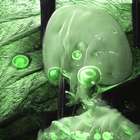Residency Rachel Wingfield (Loop.ph)
Rachel Wingfield creates reactive, luminous surfaces and objects through the use of new technologies enabling familiar products to take on a new dimension.
Rachel's research explores electronically reactive, light emitting surfaces as a form of visual communication in built spaces. The flat light source, electroluminescence is applied to traditional interior textiles in order to create sensed environments and with the use programming and sensors surfaces can be made responsive to their surroundings, providing a visual and luminous reflection of its environment. One of the key concerns is how light can be used to relieve the problems of sufferers of seasonal affect disorder, SAD, as the absence of daylight can cause severe medical problems. Light has a profound impact on our emotional and physiological being and by integrating illumination into our everyday objects and surfaces we can enhance our lives for a sense of well being. Work is created that visually illustrate the constant dialogue that occurs between our environment and its materiality. Biomimetics and growth are key elements alongside a strong reference to a textile heritage and its possible new role.
Flat display technologies are used to form reactive skins of spaces. The initial work uses fixed printed imagery of electroluminescence but with further research looks to produce an active dot-matrix print where the forms and patterns are generated solely from the sensor data, resulting in actual image growth across the surface. Like the actual physical world of living plants and organisms the material surface too will rely on environmental inputs to live and grow. This development would incorporate a more sophisticated display material. By treating the material surface as a screen with a dot-matrix function systems of growth can be achieved using simple graphic L-Systems that can be programmed to evolve naturally depending on their sensory input. The material would be biomimetic in behaviour and function in the built environment, surfacing and containing space with a continuing flow even extended to the exterior of our bodies bringing a richer visual language to the our skin, as can be seen in nature with aquatic organisms that luminesce with morphing communicating patterns.
Under the name loop Rachel Wingfield launched Digital Dawn, a reactive window lamp at 100% Design in London September where she was short listed for best new comer 2003 in the 100% Design Blueprint Awards. Digital Dawn functions as an ambient lighting product that illuminates in response to its surroundings. The window lamp digitally emulates the process of photosynthesis using electroluminescent technology. Light sensors monitor the changing ambient light levels of a space triggering the growth of organic foliage on the blind. The darker a space becomes the brighter the blind will glow maintaining a balance in luminosity. A natural environment will appear to grow and evolve on the window lamp, exploring how changing light levels can have a profound and physiological effect on our sense of well being.
In Brussels, Rachel will also exhibit the Light Sleeper, a silent alarm clock. An illuminating, personalised alarm integrated into your bedding that gently wakes you and you alone in the most natural way. Ever since the beginning of time light has controlled our body clock telling us when to sleep and when to wake. As lifestyles are rapidly changing with increased travel and demands on our time, people's natural body clocks are out of sync. This pillow and duvet simulates a natural dawn that eases you into your day. Light Sleeper Bedding is made with electroluminescent wire hand couched between silk and cotton wadding and maintains a traditional soft textile aesthetic.
Artist’s Biography
Rachel Wingfield graduated from the Royal College of Art in 2001 with an MPhil in textiles. She now works as a freelance designer and researcher on the integration of electronics and display technologies into textiles and interior surfaces, addressing future living concepts. Rachel was a finalist for the Peugeot Design Awards winning the development prize in 2002 for Light Sleeper Bedding and featured on BBC's Tomorrows World “Best New Invention 2003.” Digital Dawn was commissioned by Future Physical in collaboration with the Royal College of Art‘s Innovation Unit and Firstsite Gallery and was presented at the Eco-Technology strand in February 2003. The Eco-Technology strand explores the physical body in the natural environment in a digital age, focusing on the creative use of technology to facilitate sustainable and responsible use of the environment. Future Physical commissions represent some of the most pioneering and cutting edge digital work being created globally today.
- http://loop.ph


